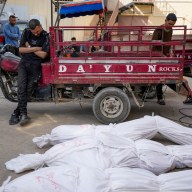As long as the franchise has been in existence, two things have been associated with the New York Giants — running the ball and playing sound defense.
Unfortunately, that identity has taken a blow in recent weeks.
Following last week’s unfathomable loss to the Seahawks, there was genuine concern regarding the running game and also how the defense’s inexplicable play has allowed opponents — some mediocre — to put up big numbers on them.
Whether it was Danario Alexander (three catches for 122 yards and touchdown) in Week 2, Beanie Wells (138 rushing yards and three touchdowns) in Week 3 or the Charlie Whitehurst to Doug Baldwin (eight catches, 136 yards and the game-winning touchdown) combination last week, Big Blue has been suffering from the blues.
It doesn’t get any easier this week, as the prolific Bills (4-1) come charging into MetLife Stadium. Everyone in the Giants’ locker room is bewildered over the state of the defense, but no one is panicking yet. And many don’t think it has anything to do with the scheme, saying it comes down to execution regardless of what play is designed.
“What difference does that make,” Tuck answered when asked if he thinks guys aren’t being put in the right position to excel. “The first thing people want to do now that we have lost a football game is point fingers. Regardless of what the play call is, you have to play above the X’s and O’s. Coaches are human and they are going to call some plays that may not be a [good] play and you just have to play above that. [Don’t worry about] being put in that right position. You put yourself in that right position.”
What’s really bothered Tuck, besides missing the last two games with groin and neck injuries, is that the defense is seemingly making different errors each game from a different culprit.
“We are not making the same errors [and] that is what is frustrating because if we were then we could just say get that guy out of there but it is different errors,” Tuck said. “One week it’s tackling, one week it is fitting up the run and the next week it may be a defensive end cutting off a blitz and a guy getting outside. Those are critical errors and every week it is something different.”
When a defense is struggling as much as the Giants (3-2) have been, a masking agent can be a strong running game that keeps the defense off the field. Unfortunately for New York, they have yet to get that element on track, even though head coach Tom Coughlin has used the rushing attack as a point of emphasis during his 16-year coaching career. Big Blue has struggled to run the ball unlike any NFL team that Coughlin has coached and any Giants team in a long time. In five games, they have rushed for 419 yards, an average of 83.8 yards per game that has them ranked 28th in the NFL.
They’re not only unproductive, but also lack the explosive home-run hitter to help pump up the feeble stats. The Giants have an NFL-low one run longer than 15 yards (Ahmad Bradshaw’s 37-yarder at Philadelphia). They have not had a back rush for more than 86 yards this season, which is the first time since 1998 that’s happened in a season’s first five games. The Giants also have not had a 100-yard rusher since Ahmad Bradshaw and Brandon Jacobs each crossed that threshold against the Vikings on Dec. 3, 2010.
Certainly those are not the type of stats that will help Eli Manning or the defense. Coughlin said he’s still very much determined to turn it around and keep the offense out of third-and-long holes. This season, the Giants have converted just 18-of-62 third-down opportunities — a 29 percent success rate that is 29th in the NFL. That is their lowest percentage through five games since 1999, when they were 18-of-70 (25.7 percent).
Getting into manageable third downs is imperative for New York this week. Especially since first-down conversions will keep the high-powered Bills offense off the field.
“Well, we’re going to keep hammering away at it because that is philosophically what I hold to and believe in,” said Coughlin. “We’re going to stay with it [and] continue to work hard at it and hopefully going to give ourselves some opportunities to allow for some play action. That will allow for shorter down and distances [because long] third downs have been terrible for us this year.”
Coughlin wouldn’t make any excuses as to why they can’t dominate on the ground. He said it didn’t matter if they’ve lost guys to injury along the offensive line (center David Baas and right guard Chris Snee) and at running back (Jacobs) or the fact teams are stacking the box and daring Manning to beat them. The Giants just have to find a way to get it done.
“You have to continue to try to run in there even when that does happen,” Coughlin said about opponents stacking the line of scrimmage. “You have to depend on your wide receivers to be able to go in there and be able to help you in that regard, too. You think that if you hit a couple play-action passes you’re going to start that guessing game. And that’s the way it goes.”
This is Coughlin’s eighth season with the Giants and since coming over from Jacksonville he has long stressed the correlation between a successful rushing attack that can help the defense, which in turn wins games.
Coughlin said it all goes hand-in-hand and once the team gains consistency in either the running game or defense everything should go back to the normalcy that is Giants football.
“There’s no consistency, let’s put it that way. Coming into this year the thing I wanted to see from us was consistency and we are not showing that,” Coughlin said. “One play’s pretty good, the next play’s not. It just seems like week-to-week, we do some good things and we do some things not so good. Let’s give credit to the guy across the ball, too. They’re trying to block some pretty good football players. But you can’t afford to have these breakdowns.”
Big Blue notes
» According to the Elias Sports Bureau, the last time the Giants have had such few rushing yards at this point in a season was 2002, when they had 411. That team, however, rallied to finish with an average of 117.2 rushing yards a game and made the playoffs, so all is not lost yet.
» To better gauge their rushing ineptness, the Giants have not finished a season averaging 83.8 or fewer rushing yards a game since 1945 (76.9) They have not been ranked 28th in rushing since 2003, when their per-game average was 97.4 yards.
»The Giants are next to last in rushing yards per-carry average (3.17), just ahead of the Titans (3.0). If they keep up this pace it’ll be the lowest per-carry average since 1953 (2.64).
»Under Coughlin, the Giants have rushed for at least 100 yards in 77 of 117 regular season games. They are 53-24 (.688 winning percentage) when they do and 15-25 (.375) when they don’t.
»Coughlin’s first 15 NFL teams averaged 126.2 rushing yards a game. In his first seven seasons here, the Giants averaged 133.7 yards per game on the ground. The fewest rushing yards a Coughlin-coached team has averaged over a full season is exactly 100.0 (the 2001 Jaguars). The highest is 157.4, the Giants’ league-leading average in 2008. Last year, the Giants averaged 137.5 rushing yards a game.
»In the 25 seasons from 1986-2010, the Giants averaged less than 100 rushing yards per game only three times – in 1987 (the strike-shortened season), 1999 and 2003.
Follow Giants beat writer Tony Williams on Twitter @TBone8.
















